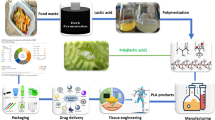Abstract
Curcumin (Cur) is a well-known extract of the root of Curcuma longa L. that has multi biological functions such as anti-oxidation, anti-inflammatory, anti-cancer, and wound healing properties. In the present study, poly (lactic acid) (PLA) nanofibers were used as a carrier for Cur because PLA nanofibers are biocompatible and have a high-specific surface area and high porosity, which can enhance the functional properties of Cur. The chemical and biological characteristics of Cur/PLA blended nanofibers containing varied amounts of Cur were examined. An increase from 0.125 to 6.250 wt% Cur in PLA caused a decrease in the diameters of the nanofibers from 971 ± 274 to 562 ± 177 nm. At Cur concentrations of <1.250 wt%, PLA and Cur showed good miscibility in the blended nanofibers, as shown by FTIR analysis and tensile tests. The inclusion of Cur in the blended nanofibers at concentration as low as 0.125 wt% promotes the attachment and proliferation of cells. The in vivo wound healing capability of Cur-loaded PLA nanofibers was assessed in a mouse model; treatment with Cur-loaded PLA nanofibers significantly increased the rate of wound closure (87 %) by day 7 compared with that of PLA nanofibers (58 %). The results of this study suggest that Cur-loaded nanofibers with appropriate Cur concentration are nontoxic and have potential as component of wound-healing patches.








Similar content being viewed by others
References
Bhardwaj N, Kundu SC (2010) Biotechnol Adv 28:325
Wang HS, Fu GD, Li XS (2009) Recent Pat Nanotechnol 3:21
Sill TJ, von Recum HA (2008) Biomaterials 29:1989
Liang D, Hsiao BS, Chu B (2007) Adv Drug Deliv Rev 59:1392
Zahedi P, Rezaeian I, Ranaei-Siadat SO, Jafari SH, Supaphol P (2010) Polym Adv Technol 21:77
Chong EJ, Phan Lim IJ, Zhang YZ, Bay BH, Ramakrishna S, Lim CT (2007) Acta Biomater 3:321
Powell HM, Supp DM, Boyce ST (2008) Biomaterials 29:834
Choi JS, Leong KW, Yoo HS (2008) Biomaterials 29:587
Khil MS, Cha DI, Kim HI, Kim IS, Bhattarai N (2003) J Biomed Mater Res B 67B:675
Liu SJ, Kau YC, Chou CY, Chen JK, Wu RC, Yeh WL (2010) J Membr Sci 355:53
Chen ZG, Wang PW, Wei B, Mo XM, Cui FZ (2010) Acta Biomater 6:372
Liu X, Lin T, Fang Z, Yao G, Wang XG (2008) Adv Sci Technol 57:125
Schneider A, Wang XY, Kaplan DL, Garlick JA, Egles C (2009) Acta Biomater 5:2570
Bölgen N, Vargel I, Korkusuz P, Menceloğlu YZ, Pişkin E (2007) J Biomed Mater Res B 81B:530
Chen Y, Lin J, Fei Y, Wang H, Gao W (2010) Fiber Polym 11:1128
Kössler S, Nofziger C, Jakab M, Dossena S, Paulmichl M (2012) Toxicology 292:123
Maheshwari RK, Singh AK, Gaddipati J, Srimal RC (2006) Life Sci 78:2081
Srivastava RM, Singh S, Dubey SK, Misra K, Khar A (2011) Int Immunopharmacol 11:331
Notoya M, Nishimura H, Woo JT, Nagai K, Ishihara Y, Hagiwara H (2006) Eur J Pharmacol 534:55
Panchatcharam M, Miriyala S, Gayathri V, Suguna L (2006) Mol Cell Biochem 290:87
Sidhu GS, Singh AK, Thaloor D, Banaudha KK, Patnaik GK, Srimal RC, Maheshwari RK (1998) Wound Repair Regen 6:167
Gou M, Men K, Shi H, Xiang M, Zhang J, Song J, Long J, Wan Y, Luo F, Zhao X, Qian Z (2011) Nanoscale 3:1558
Wang X, Jiang Y, Wang YW, Huang MT, Ho CT, Huang Q (2008) Food Chem 108:419
Kumar V, Lewis SA, Mutalik S, Shenoy DB, Venkatesh, Udupa N (2002) Indian J Physiol Pharmacol 46:209
Gopinath D, Ahmed MR, Gomathi K, Chitra K, Sehgal PK, Jayakumar R (2004) Biomaterials 25:1911
Ratanajiajaroen P, Watthanaphanit A, Tamura H, Tokura S, Rujiravanit R (2012) Eur Polym J 48:512
Merrell JG, McLaughlin SW, Tie L, Laurencin CT, Chen AF, Nair LS (2009) Clin Exp Pharmacol Physiol 36:1149
Suwantong O, Ruktanonchai U, Supaphol P (2010) J Biomed Mater Res A 94A:1216
Foldberg S, Petersen M, Fojan P, Gurevich L, Fink T, Pennisi CP, Zachar V (2012) Colloid Surf B 93:92
Evans RGD, Brandt K, Katz S, Chauvin P, Otto L, Bogle M, Wang B, Meszlenyi RK, Lu L, Mikos AG, Patrick CW Jr (2002) Biomaterials 23:841
Gu SY, Ren J (2005) Macromol Mater Eng 290:1097
Ribeiro C, Sencadas V, Costa CM, Ribelles JL, Lanceros-Mendez S (2011) Sci Technol Adv Mater 12:015001
Rahman NA, Gizdavic-Nikolaidis M, Ray S, Easteal AJ, Travas-Sejdic J (2010) Synth Met 160:2015
Gizdavic-Nikolaidis M, Ray S, Bennett J, Swift S, Bowmaker G, Easteal A (2011) J Polym Sci Polym Chem 49:4902
Andrady AL (2008) Science and technology of polymer nanofibers. Wiley, New Jersey
Nguyen TTT, Ghosh C, Hwang SG, Chanunpanich N, Park JS (2012) Int J Pharm 439:296
Woo JH, Kim YH, Choi YJ, Kim DG, Lee KS, Bae JH, Min DS, Chang JS, Jeong YJ, Lee YH, Park JW, Kwon TK (2003) Carcinogenesis 24:1199
Scharstuhl A, Mutsaers HAM, Pennings SWC, Szarek WA, Russel FGM, Wagener FDA (2009) J Cell Mol Med 13:712
Acknowledgements
This project was partially financially supported by the “2011 Overseas Benchmarking Program of Hankyong National University”.
Author information
Authors and Affiliations
Corresponding author
Rights and permissions
About this article
Cite this article
Nguyen, T.T.T., Ghosh, C., Hwang, SG. et al. Characteristics of curcumin-loaded poly (lactic acid) nanofibers for wound healing. J Mater Sci 48, 7125–7133 (2013). https://doi.org/10.1007/s10853-013-7527-y
Received:
Accepted:
Published:
Issue Date:
DOI: https://doi.org/10.1007/s10853-013-7527-y




